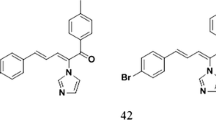Abstract
Fluconazole is an effective alternative to amphotericin B for the treatment of serious infections caused byCandida albicans. Through a literature survey of candidal infections caused by non-albicans Candida spp., 43 cases treated with fluconazole were found. The most common causative organisms wereCandida parapsilosis (14 patients),Candida glabrata (12 patients), andCandida tropicalis (11 patients). The dose of fluconazole varied from 50 to 400 mg daily. The median duration of treatment was 21 days. Overall efficacy was 77%. The efficacy against the various species was 93% forCandida parapsilosis, 50% forCandida glabrata, and 82% forCandida tropicalis. In conclusion, fluconazole is effective against the most commonnonalbicans Candida spp., although higher doses may be required for infections caused byCandida glabrata. Infections caused byCandida krusei should not be treated with fluconazole.
Similar content being viewed by others

References
Wingard JR: Importance ofCandida species other thanCandida albicans as pathogens in oncology patients. Clinical Infectious Diseases 1995, 20: 115–125.
Edwards JE:Candida species. In: Mandell GE, Bennett JE, Dolin R (ed): Principles and practice of infectious diseases. Churchill Livingstone, New York, 1995, p. 2289–2306.
Graninger W, Presteril E, Schneeweiss B, Teleky B, Georgopoulos A: Treatment ofCandida albicans fungaemia with fluconazole. Journal of Infection 1993, 26: 133–146.
Kujath P, Lerch K: Secondary mycosis in surgery: treatment with fluconazole. Infection 1989, 17: 111–117.
Tolkoff-Rubin NE, Conti DJ, DelVecchio A, Rubin RH: Fluconazole in the treatment of invasive candidal and cryptococcal infections in organ transplant recipients. Pharmacotherapy 1990, 10, Supplement 6: 159–163.
Van't Wout JW, Mattie H, Van Furth R: A prospective study of the efficacy of fluconazole (UK 49,858) against deep-seated infections. Antimicrobial Agents and Chemotherapy 1988, 31: 665–672.
Anaissie E, Bodey GP, Kantarjian H, David C, Barnett K, Bow E, Defelice R, Downs N, File T, Karam G, Potts D, Shelton M, Sugar A: Fluconazole therapy for chronic disseminated candidiasis in patients with leukemia and prior amphotericin B therapy. American Journal of Medicine 1991, 91: 142–150.
Kauffman CA, Bradley SF, Ross SC, Weber DR: Hepatosplenic candidiasis: successful treatment with fluconazole. American Journal of Medicine 1991, 91: 137–141.
Rex JH, Bennett JE, Sugar AM, Pappas PG, van der Horst CM, Edwards JE, Washburn RG, Scheld WM, Karchmer AW, Dine AP, Levenstein MJ, Webb CD: A randomized trial comparing fluconazole with amphotericin B for treatment of candidemia in patients without neutropenia. New England Journal of Medicine 1994, 331: 1325–1330.
Persons DA, Laughlin M, Tanner D, Perfect J, Gockerman JP, Hathorn JW: Fluconazole andCandida krusei fungemia. New England Journal of Medicine 1991, 325: 1315.
Wingard JR, Merz WG, Rinaldi MG, Johnson TR, Karp JE, Saral R: Increase inCandida krusei infection among patients with bone marrow transplantation and neutropenia treated prophylactically with fluconazole. New England Journal of Medicine 1991, 325: 1274–1277.
Wingard JR, Merz WG, Rinaldi MG, Miller CB, Karp JE, Saral R: Association ofTorulopsis glabrata infections with fluconazole prophylaxis in neutropenic bone marrow transplant patients. Antimicrobial Agents and Chemotherapy 1993, 37: 1847–1849.
Bren A, Kandus A, Lindic J, Varl J: Fluconazole in the treatment of fungal infections in kidney-transplanted patients. Transplantation Proceedings 1992, 24: 2765–2766.
Levine J, Bernard DB, Idelson BA, Farnham H, Saunders C, Sugar AM: Fungal peritonitis complicating continuous ambulatory peritoneal dialysis: successful treatment with fluconazole, a new orally active antifungal agent. American Journal of Medicine 1989, 86: 825–827.
Isalska B, Stanbridge TN: Fluconazole in the treatment of candidal prosthetic valve endocarditis. British Medical Journal 1988, 297: 178–179.
Martino P, Meloni G, Cassone A: Candidal endocarditis and treatment with fluconazole and granulocyte-macrophage colony-stimulating factor. Annals of Internal Medicine 1990, 112: 966–967.
Cohen J: Treatment of systemic yeast infection with fluconazole. Journal of Antimicrobial Chemotherapy 1989, 23: 294.
Urbak SF, Degn T: Fluconazole in the management of fungal ocular infections. Ophthalmologica 1994, 28: 147–156.
Corbella X, Carratala J, Castells M, Berlanga B: Fluconazole treatment inTorulopsis glabrata upper urinary tract infection causing ureteral obstruction. Journal of Urology 1991, 147: 1116–1117.
Flannery MT, Simmons DB, Saba H, Altus P, Wallach PM, Adelman HM: Fluconazole in the treatment of hepatosplenic candidiasis. Archives of Internal Medicine 1992, 152: 406–408.
Thomas MG, Ellis-Pegler RB: Fluconazole treatment ofCandida glabrata peritonitis. Journal of Antimicrobial Chemotherapy 1989, 24: 94–95.
Mcllroy MA: Failure of fluconazole to suppress fungemia in a patient with fever, neutropenia, and typhlitis. Journal of Infectious Diseases 1991, 163: 420–421.
Nolla-Salas J, Léon C, Torres-Rodríquez JM, Martín E, Sitges-Serra A: Treatment of candidemia in critically ill surgical patients with intravenous fluconazole. Clinical Infectious Diseases 1992, 14: 952–954.
Meunier F: Fluconazole treatment of fungal infections in the immunocompromised host. Seminars in Oncology 1990, 17: 19–23.
Milatovic D, Voss A: Efficacy of fluconazole in the treatment of systemic fungal infections. European Journal of Clinical Microbiology & Infectious Diseases 1992, 11: 395–402.
National Committee for Clinical Laboratory Standards: Reference method for broth dilution antifungal susceptibility testing of yeasts. Proposed standard M27-P. NCCLS, Villanova, PA, 1992.
Rex JH, Pfaller MA, Barry AL, Nelson PW, Webb CD and The NIAID Mycosis Study Group and The Candidemia Study Group: Antifungal susceptibility testing of isolates from a randomized, multicenter trial of fluconazole versus amphotericin B as treatment of nonneutropenic patients with candidemia. Antimicrobial Agents and Chemotherapy 1995, 39: 40–44.
Author information
Authors and Affiliations
Rights and permissions
About this article
Cite this article
van't Wout, J.W. Fluconazole treatment of Candidal infections caused by non-Albicans Candida species. Eur. J. Clin. Microbiol. Infect. Dis. 15, 238–242 (1996). https://doi.org/10.1007/BF01591361
Issue Date:
DOI: https://doi.org/10.1007/BF01591361



